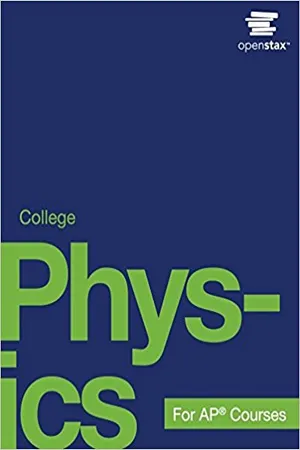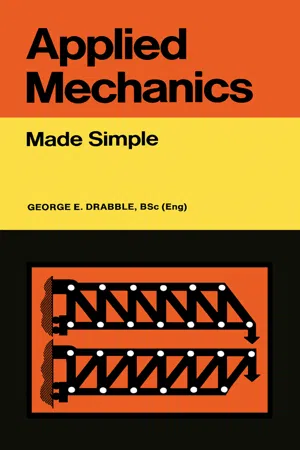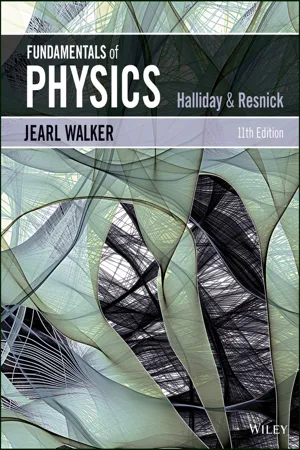Physics
Displacement
Displacement in physics refers to the overall change in position of an object, typically measured in a straight line from the starting point to the ending point. It is a vector quantity, meaning it has both magnitude and direction. Displacement can be positive, negative, or zero, depending on the direction of the movement relative to the reference point.
Written by Perlego with AI-assistance
Related key terms
1 of 5
11 Key excerpts on "Displacement"
- eBook - PDF
- David Halliday, Robert Resnick, Jearl Walker(Authors)
- 2021(Publication Date)
- Wiley(Publisher)
67 4.1 POSITION AND Displacement Learning Objectives After reading this module, you should be able to . . . 4.1.1 Draw two-dimensional and three-dimensional position vectors for a particle, indicating the components along the axes of a coordinate system. 4.1.2 On a coordinate system, determine the direction and magnitude of a particle’s position vector from its components, and vice versa. 4.1.3 Apply the relationship between a particle’s dis- placement vector and its initial and final position vectors. Key Ideas ● The location of a particle relative to the origin of a coordinate system is given by a position vector r → , which in unit-vector notation is r → = x ˆ i + y ˆ j + z k ̂ . Here x ˆ i, y ˆ j, and z k ̂ are the vector components of posi- tion vector r → , and x, y, and z are its scalar components (as well as the coordinates of the particle). ● A position vector is described either by a magnitude and one or two angles for orientation, or by its vector or scalar components. ● If a particle moves so that its position vector changes from r → 1 to r → 2 , the particle’s Displacement Δ r → is Δ r → = r → 2 − r → 1 . The Displacement can also be written as Δ r → = ( x 2 − x 1 ) ˆ i + ( y 2 − y 1 ) ˆ j + ( z 2 − z 1 )k ̂ = Δx ˆ i + Δy ˆ j + Δz k ̂ . What Is Physics? In this chapter we continue looking at the aspect of physics that analyzes motion, but now the motion can be in two or three dimensions. For example, medical researchers and aeronautical engineers might concentrate on the physics of the two- and three-dimensional turns taken by fighter pilots in dogfights because a modern high-performance jet can take a tight turn so quickly that the pilot immediately loses consciousness. A sports engineer might focus on the physics of basketball. For example, in a free throw (where a player gets an uncontested shot at the basket from about 4.3 m), a player might employ the overhand push shot, in which the ball is pushed away from about shoulder height and then released. - eBook - PDF
- Paul Peter Urone, Roger Hinrichs(Authors)
- 2012(Publication Date)
- Openstax(Publisher)
elapsed time: free-fall: independent variable: instantaneous acceleration: instantaneous speed: instantaneous velocity: kinematics: model: position: scalar: slope: time: vector: y-intercept: the difference between the ending time and beginning time the state of movement that results from gravitational force only the variable that the dependent variable is measured with respect to; usually plotted along the x -axis acceleration at a specific point in time magnitude of the instantaneous velocity velocity at a specific instant, or the average velocity over an infinitesimal time interval the study of motion without considering its causes simplified description that contains only those elements necessary to describe the physics of a physical situation the location of an object at a particular time a quantity that is described by magnitude, but not direction the difference in y -value (the rise) divided by the difference in x -value (the run) of two points on a straight line change, or the interval over which change occurs a quantity that is described by both magnitude and direction the y- value when x = 0, or when the graph crosses the y -axis Section Summary 2.1 Displacement • Kinematics is the study of motion without considering its causes. In this chapter, it is limited to motion along a straight line, called one-dimensional motion. • Displacement is the change in position of an object. • In symbols, Displacement Δx is defined to be Δx = x f − x 0 , where x 0 is the initial position and x f is the final position. In this text, the Greek letter Δ (delta) always means “change in” whatever quantity follows it. The SI unit for Displacement is the meter (m). Displacement has a direction as well as a magnitude. • When you start a problem, assign which direction will be positive. • Distance is the magnitude of Displacement between two positions. • Distance traveled is the total length of the path traveled between two positions. - eBook - PDF
Engineering Science N2 Student's Book
TVET FIRST
- MJJ van Rensburg(Author)
- 2016(Publication Date)
- Troupant(Publisher)
To understand the science of dynamics, you must not only know the basic concepts but also be able to distinguish between them. In this unit, we will distinguish between concepts such as distance and Displacement, speed and velocity, scalars and vectors. We will also look at other concepts relevant to the field of dynamics. Note In this book, the unit symbols are often used interchangeably. In other words, in one calculation you may see the unit symbol m/s for speed, and in another you may see m.s –1 . This has been done on purpose so that you can get used to the different unit symbols. Distance and Displacement The change of position of a body can be described by: • Distance ( s ): This is the total distance travelled from the starting point of a journey to the end of the journey. For example, during a road trip the distance travelled is measured by the odometer of the car. • Displacement ( s ): This is the shortest distance between the origin and the final destination . For example, if an athlete circles a track with a circumference of 400 m once, the distance covered is 400 m, but the athlete’s Displacement is zero, as there is no change of position (see Figure 1.2). Figure 1.2: On a circular track, the athlete’s Displacement is zero because his/her initial and final positions (points A and A’) are the same Figure 1.3 illustrates the difference between distance and Displacement. If you travel in a straight line directly from A to B it will be the shortest distance between the two points. This represents the Displacement between points A and B. All other routes will be a measure of the distance between A and B. The SI unit for both distance and Displacement is the metre (m). Figure 1.3: Displacement and distances between points A and B odometer: an instrument that measures the distance travelled by a vehicle 3 Displacement is always equal to or less than distance, i.e. - eBook - PDF
From Atoms to Galaxies
A Conceptual Physics Approach to Scientific Awareness
- Sadri Hassani(Author)
- 2010(Publication Date)
- CRC Press(Publisher)
Section 6.2 Parallax 75 Displacement is denoted by Δ r or r 12 , or (rarely) d , and is usually measured in meters. In terms of the position vectors r 1 and r 2 , we have Δ r = r 2 -r 1 , and this defines the difference between two position vectors. What do you know? 6.4. Karl and Emmy don’t move relative to one another. They look at a car move from an initial point to a final point. Does Emmy see the same initial position vector for the car as Karl? Does she see the same final position vector as him? Does she see the same Displacement for the car as him? What if Emmy moves relative to Karl? You have to differentiate between distance and Displacement. Distance is the length of the path that an object takes in going from an initial point to the final point. For example, in Figure 6.1, the Displacement between A 1 and A 3 , denoted by r 13 , is simply the directed straight line segment from A 1 to A 3 , while the distance is the length of the curved path joining the two points. Position is only one of the ingredients of motion. Another ingredient is time. The concept of time is much harder to explain than position. Even an operational definition of time is not straightforward. To define time operationally, you need to be able to measure time. What is time? This involves a measuring device (a clock), just as the measurement of position involves a pair of measuring devices (a meter stick to measure length and a compass to measure direction). 2 However, although it is conceptually easy to construct a meter stick and a compass, it is difficult to come up with a good clock. Ironically, it is only after physicists mastered the concept of motion that they were able to determine what a good clock is. We shall not dwell on this subject any further and simply assume that there exist good clocks. (However, you may find Food for Thought 18.1.1 relevant to the present discussion.) Example 6.1.3. - eBook - PDF
- Michael Tammaro(Author)
- 2019(Publication Date)
- Wiley(Publisher)
Examples of vectors: position (e.g., 1.5 km north or 3.5 m in the positive x direction), velocity (2.0 m/s in the negative y direction), and force (5.5 N in the negative z direction). Going Deeper Scalar Quantities and Vector Quantities I N T E R A C T I V E F E A T U R E Position and Displacement: Vectors in One Dimension | 45 Displacement is the difference between two vectors, so it is also a vector. In mathematics, the symbol ∆ usually means change in or difference in and is equal to the final value minus the initial value of the changing quantity. Figure 2.1.2 When the initial position is +9.00 m and the final position is +2.00 m, the displace- ment is −7.00 m. +x 0 x = +2.00 m x 0 = +9.00 m Definition of Displacement When an object moves from place to place, the magnitude of its Displacement is equal to the straight-line distance between the initial and final positions. The direction of the Displacement is measured from the initital position toward the final position. The Displacement depends only on the initial and final positions, and not on the details of the path taken. In Figure 2.1.2, the bear is initially facing right, suggesting that the bear first rode some unspecified distance in the positive direction before turning around and riding back to the final position. We distinguish between the distance (the total length of travel) and the magnitude of the Displacement. Unless the path from the initial to the final position was a straight line with no backtracking, the distance traveled will be greater than the magnitude of the Displacement. Adding and Subtracting Vectors in One Dimension Sometimes it is necessary or useful to depict vectors graphically, in which case they are represented as arrows. The direction of the arrow should be consistent with the coordinate system in the diagram, and the length of the arrow should be proportional to the vector’s magnitude. - eBook - PDF
Applied Mechanics
Made Simple
- George E. Drabble(Author)
- 2013(Publication Date)
- Made Simple(Publisher)
I should add hastily that this is an illus-trative example only. No practising engineer is likely to spend his time in working out such an unlikely quantity as this. But it at least gives rise to the teasing question of what is the true Displacement of the rotor, and the even more teasing answer that there is no such quantity. Displacements can only be stated relative to some point in space. For practical engineers, the point is usually a point on the Earth's surface, and for most cases this is assumed to be fixed. Another way of putting this is that, in calculations involving prac-tically all motions of bodies on the Earth, the motion of the Earth itself can be ignored. It is, of course, a very different matter when a journey to the Moon is projected. The Sun then becomes the 'fixed' point. Displacement is not the only quantity where we have to make use of special rules to perform addition. We shall find in Chapter Three that the same rules apply to force. Any quantity that is derived from Displacement must also conform—as we are about to discover. Any quantity which requires these special rules of addition is called a vector quantity. (2) Velocity and Speed We have examined the nature of Displacement in some detail. As a result, we can be reasonably brief in our examination of velocity, which is the rate of change of Displacement. Miles per hour, kilometres per hour, feet per second, metres per second, are examples of the specification of velocity. Since the specification of Displacement requires direction as well as magnitude, so must that of velocity. A velocity of 60 kilometres per hour is only half the story: the other half is the direction in which it takes place. The mere magnitude, irrespective of direction, is called the speed. The distinction is important because it means that, if the speed changes, the velocity must change, but the velocity may change without the speed changing. - eBook - PDF
- David Halliday, Robert Resnick, Jearl Walker(Authors)
- 2018(Publication Date)
- Wiley(Publisher)
62 C H A P T E R 4 Motion in Two and Three Dimensions 4-1 POSITION AND Displacement Learning Objectives After reading this module, you should be able to . . . 4.01 Draw two-dimensional and three-dimensional posi- tion vectors for a particle, indicating the components along the axes of a coordinate system. 4.02 On a coordinate system, determine the direction Key Ideas ● The location of a particle relative to the origin of a coordinate system is given by a position vector r → , which in unit-vector notation is r → = xi ˆ + yj ˆ + zk ˆ . Here xi ˆ , y j ˆ , and zk ˆ are the vector components of position vector r → , and x, y, and z are its scalar components (as well as the coordinates of the particle). ● A position vector is described either by a magnitude What Is Physics? In this chapter we continue looking at the aspect of physics that analyzes motion, but now the motion can be in two or three dimensions. For example, medical researchers and aeronautical engineers might concentrate on the physics of the two- and three-dimensional turns taken by fighter pilots in dogfights because a modern high-performance jet can take a tight turn so quickly that the pilot immediately loses consciousness. A sports engineer might focus on the physics of basketball. For example, in a free throw (where a player gets an uncontested shot at the basket from about 4.3 m), a player might employ the overhand push shot, in which the ball is pushed away from about shoulder height and then released. Or the player might use an underhand loop shot, in which the ball is brought upward from about the belt-line level and released. The first technique is the overwhelm- ing choice among professional players, but the legendary Rick Barry set the record for free-throw shooting with the underhand technique. Motion in three dimensions is not easy to understand. - eBook - PDF
An Integrated Framework for Structural Geology
Kinematics, Dynamics, and Rheology of Deformed Rocks
- Steven Wojtal, Tom Blenkinsop, Basil Tikoff(Authors)
- 2022(Publication Date)
- Wiley(Publisher)
66 An Integrated Framework for Structural Geology: Kinematics, Dynamics, and Rheology of Deformed Rocks, First Edition. Steven Wojtal, Tom Blenkinsop, and Basil Tikoff. © 2022 John Wiley & Sons Ltd. Published 2022 by John Wiley & Sons Ltd. 4 4.1 Overview Displacements are a fundamental and observable property of rock deformation. A Displacement describes the movement of a particle from an ini- tial position to a final position. In order to define a Displacement, we must specify both the direction and distance or magnitude that the particle moved. Since Displacements have both magnitude and direction, we represent them mathematically as vectors. In cases where structural geologists can determine a series of positions that a particle occupied over a long time interval, we distinguish Displacement path, the route through space fol- lowed by a particle, and Displacement history, the timing of when particles occupied different positions along the Displacement path. If we know the times at which a particle occupied two positions, we can calculate its Displacement rate (or velocity) by dividing the Displacement during that time interval by the length of the time inter- val. In studies of deformation that occurred long ago, the limited precision of dating techniques means that we can only calculate average dis- placement rates over millennia. Studies of neotec- tonic deformation typically measure Displacement rates that have prevailed over time intervals of decades to centuries. Long-term average displace- ment rates may differ from short-period rates. For example, average Displacement rates determined for movement on individual faults typically are millimeters per year to centimeters per year, but during earthquakes, Displacement rates can be meters per second. The collection of Displacement vectors for the particles originally found at different positions defines a Displacement field. - eBook - PDF
- William Moebs, Samuel J. Ling, Jeff Sanny(Authors)
- 2016(Publication Date)
- Openstax(Publisher)
The angle the Displacement makes with the x-axis is θ = tan −1 ⎛ ⎝ −11,557 4787 ⎞ ⎠ = −67.5°. Significance Plotting the Displacement gives information and meaning to the unit vector solution to the problem. When plotting the Displacement, we need to include its components as well as its magnitude and the angle it makes with a chosen axis—in this case, the x-axis (Figure 4.5). 160 Chapter 4 | Motion in Two and Three Dimensions This OpenStax book is available for free at http://cnx.org/content/col12031/1.5 Figure 4.5 Displacement vector with components, angle, and magnitude. Note that the satellite took a curved path along its circular orbit to get from its initial position to its final position in this example. It also could have traveled 4787 km east, then 11,557 km south to arrive at the same location. Both of these paths are longer than the length of the Displacement vector. In fact, the Displacement vector gives the shortest path between two points in one, two, or three dimensions. Many applications in physics can have a series of Displacements, as discussed in the previous chapter. The total Displacement is the sum of the individual Displacements, only this time, we need to be careful, because we are adding vectors. We illustrate this concept with an example of Brownian motion. Example 4.2 Brownian Motion Brownian motion is a chaotic random motion of particles suspended in a fluid, resulting from collisions with the molecules of the fluid. This motion is three-dimensional. The Displacements in numerical order of a particle undergoing Brownian motion could look like the following, in micrometers (Figure 4.6): Δ r → 1 = 2.0 i ^ + j ^ + 3.0 k ^ Δ r → 2 = − i ^ + 3.0 k ^ Δ r → 3 = 4.0 i ^ − 2.0 j ^ + k ^ Δ r → 4 = −3.0 i ^ + j ^ + 2.0 k ^ . What is the total Displacement of the particle from the origin? Chapter 4 | Motion in Two and Three Dimensions 161 Figure 4.6 Trajectory of a particle undergoing random Displacements of Brownian motion. - eBook - PDF
- John D. Cutnell, Kenneth W. Johnson, David Young, Shane Stadler(Authors)
- 2015(Publication Date)
- Wiley(Publisher)
The beautiful water fountain at the World War II Memorial in Washington, D.C., is illuminated at night. The arching streams of water follow parabolic paths whose sizes depend on the launch velocity of the water and the acceleration due to gravity, assuming that the effects of air resis- tance are negligible. Chapter | 3 LEARNING OBJECTIVES After reading this module, you should be able to... 3.1 | Define two-dimensional kinematic variables. 3.2 | Use two-dimensional kinematic equations to predict future or past values of variables. 3.3 | Analyze projectile motion to predict future or past values of variables. 3.4 | Apply relative velocity equations. 3.1 | Displacement, Velocity, and Acceleration In Chapter 2 the concepts of Displacement, velocity, and acceleration are used to describe an object moving in one dimension. There are also situations in which the motion is along a curved path that lies in a plane. Such two-dimensional motion can be described using the same concepts. In Grand Prix racing, for example, the course follows a curved road, and Figure 3.1 shows a race car at two different positions along it. These positions are iden- tified by the vectors r B and r B 0 , which are drawn from an arbitrary coordinate origin. The Displacement D r B of the car is the vector drawn from the initial position r B 0 at time t 0 to the final position r B at time t. The magnitude of D r B is the shortest distance between the two positions. In the drawing, the vectors r B 0 and D r B are drawn tail to head, so it is evident that r B is the vector sum of r B 0 and D r B . (See Sections 1.5 and 1.6 for a review of vectors and vector addition.) This means that r B 5 r B 0 1 D r B , or Displacement 5 D r B 5 r B 2 r B 0 The Displacement here is defined as it is in Chapter 2. Now, however, the Displacement vector may lie anywhere in a plane, rather than just along a straight line. - eBook - PDF
- John D. Cutnell, Kenneth W. Johnson, David Young, Shane Stadler(Authors)
- 2018(Publication Date)
- Wiley(Publisher)
LEARNING OBJECTIVES After reading this module, you should be able to... 3.1 Define two-dimensional kinematic variables. 3.2 Use two-dimensional kinematic equations to predict future or past values of variables. 3.3 Analyze projectile motion to predict future or past values of variables. 3.4 Apply relative velocity equations. © threespeedjones/iStockphoto CHAPTER 3 Kinematics in Two Dimensions The beautiful water fountain at the World War II Memorial in Washington, D.C., is illuminated at night. The arching streams of water follow parabolic paths whose sizes depend on the launch velocity of the water and the acceleration due to gravity, assuming that the effects of air resistance are negligible. 3.1 Displacement, Velocity, and Acceleration In Chapter 2 the concepts of Displacement, velocity, and acceleration are used to describe an object moving in one dimension. There are also situations in which the motion is along a curved path that lies in a plane. Such two-dimensional motion can be described using the same concepts. In Grand Prix racing, for example, the course follows a curved road, and Figure 3.1 shows a race car at two different positions along it. These positions are identified by the vectors r → and r → 0 , which are drawn from an arbitrary coordinate origin. The Displacement Δ r → of the car is the vector drawn from the initial position r → 0 at time t 0 to the final position r → at time t. The magnitude of Δ r → is the shortest distance between the two positions. In the drawing, the vectors r → 0 and Δ r → are drawn tail to head, so it is evident that r → is the vector sum of r → 0 and Δ r → . (See Sections 1.5 and 1.6 for a review of vectors and vector addition.) This means that r → = r → 0 + Δ r → , or Displacement = Δ r → = r → − r → 0 The Displacement here is defined as it is in Chapter 2. Now, however, the Displacement vector may lie anywhere in a plane, rather than just along a straight line. 55
Index pages curate the most relevant extracts from our library of academic textbooks. They’ve been created using an in-house natural language model (NLM), each adding context and meaning to key research topics.










